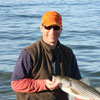Buying a First Boat
By Tom Keer
Mar 11, 2015
I remember buying my first boat like it was yesterday.
I remember buying my first boat like it was yesterday. Perhaps it’s because all I have to do is to walk to my driveway and see her. It’s been 20 years since I bought her and over that time we’ve become old friends. We’ve spent a lot of time on the water together, left a lot of fish scales on the bow and stern, and even come home fishless on occasion. When I bought her I went through a process that was time consuming but made a difference.
My first step was to honestly evaluate the kind of fishing I would do with her; ninety per cent was going to be inshore saltwater. I planned on targeting striped bass, bluefish, squeteague, bonito, and false albacore. Since these fish are migratory I’d need a boat I could trailer across state lines to where the fishing was hot. Once there I’d fish flats, estuaries, rips, reefs, inshore islands, ledges, and the like, all in depths under 100 feet of water. For that I’d need a modified vee hull center console in easy-to-maintain fiberglass. This kind of boat could also be used in freshwater ponds and lakes which represented the remaining ten per cent of my time on the water.
My choice in length would have to be between 18 and 23 feet to handle the seas on a choppy day. For maintenance, I preferred an outboard to an inboard. She’d need to be stable and beamy, seaworthy, and easy to launch/haul on my own. Most of my bait fishing is done from shore, and on board I’d use conventional, trolling or fly gear (no live would be necessary). Since I live on the coast I didn’t need a cabin or a head which made my decision easier.
Cost was a factor, and I looked at a number of new and used boats with those characteristics. One option was to buy a used hull and if the outboard was beat up I could always repower. The second option was to buy a new boat, motor and trailer package. Back in the 1990’s an 18-22 foot center console was all the rage, and the used boat market offered slim pickings. Higher powered outboards cost a lot of money, so I chose a work skiff that I could easily modify into a fishing machine. Instead of a 200HP or above I could get away with a 90HP and on a calm day I could cruise at 30 MPH.
Financing was an option, and due to the extended length of the loan the total cost was $130/month. When gas went to $6.00/gallon on the gas docks I pulled up to the local gas station where it was $4.00. I went with a fuel efficient 4-stroke engine which kept more money in my pocket (Nowadays, with lower gas prices, things can be a little easier).
On some days when it’s snotty on the water I wish I had a bigger, heavier boat, and the point is that there is no one perfect boat. But there is one that is good enough. So figuring out what kind of boat will satisfy the majority of your fishing conditions and hit your budget is the easiest way to find a first boat. The amount of joy it will bring you is priceless.
If you would like to have more information, check our boating section: http://takemefishing.org/boating/overview/









